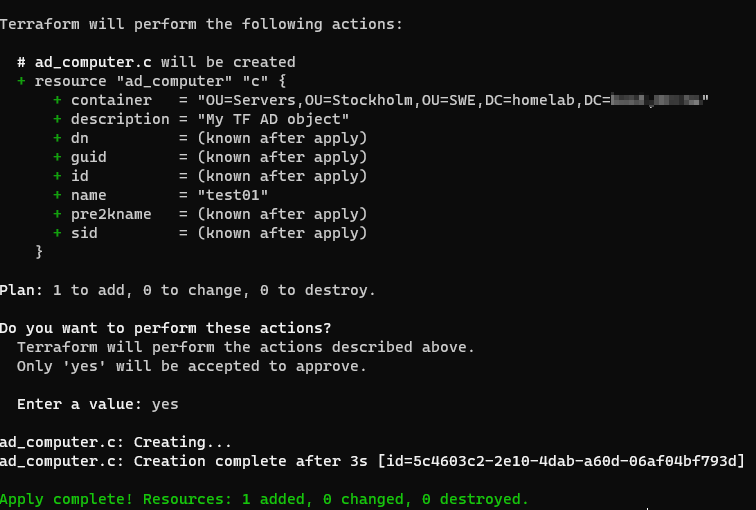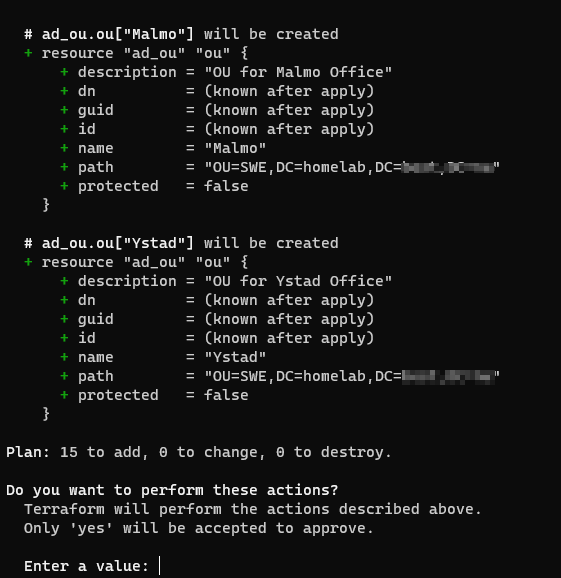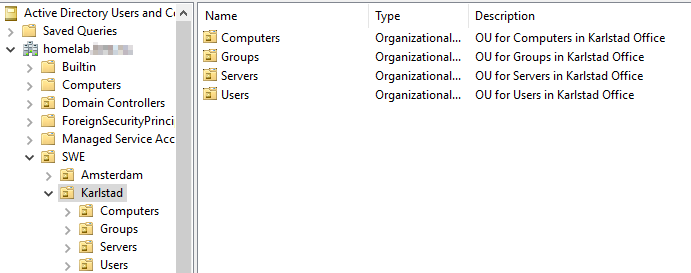Terraform and Active Directory
I have worked a lot with AD during the past years mostly with powershell. This time I needed to create a AD computer object with terraform and started to look into how to setup terraform AD provider.
First you need to configure the provider. I am running terraform on my non domain joined laptop. Terraform needs winrm access to a domain joined server with Active directory powershell modules installed. It’s important to use capital letters in all FQDNs for kerberos to work both in provider.tf and krb5.conf.
provider.tf
1
2
3
4
5
6
7
8
9
10
11
12
provider "ad" {
winrm_hostname = "SERVER.HOMELAB.DOMAIN.COM"
winrm_username = var.aduser
winrm_password = var.adpassword
winrm_port = 5986
winrm_proto = "https"
winrm_pass_credentials = true
krb_realm = "HOMELAB.DOMAIN.COM"
krb_conf = "krb5.conf"
krb_spn = "SERVER"
winrm_insecure = true
}
We also need to create krb5.conf in order to set up kerberos authentication
1
2
3
4
5
6
7
8
9
10
11
12
13
14
15
16
17
18
[libdefaults]
default_realm = HOMELAB.DOMAIN.COM
dns_lookup_realm = false
dns_lookup_kdc = false
[realms]
HOMELAB.DOMAIN.COM = {
kdc = DC01.HOMELAB.DOMAIN.COM
admin_server = DC01.HOMELAB.DOMAIN.COM
default_domain = HOMELAB.DOMAIN.COM
master_kdc = DC01.HOMELAB.DOMAIN.COM
}
[domain_realm]
.kerberos.server = HOMELAB.DOMAIN.COM
.homelab.domain.com = HOMELAB.DOMAIN.COM
homelab.domain.com = HOMELAB.DOMAIN.COM
Now the provider should be configured and ready to use. Next step is to create a AD computer object in main.tf.
1
2
3
4
5
resource "ad_computer" "c" {
name = "test01"
container = "OU=Servers,OU=Stockholm,OU=SWE,DC=homelab,DC=domain,DC=com"
description = "My TF AD object"
}
To test the code run terraform apply -var aduser=adadmin -var adpassword=secretpw123
and wait for output.and type yes if everything seems fine.
Now we have a new computer object in AD managed with terraform.
Next thing I wanted to test was a bit more complex. I wanted to create a OU structure with several sub OUs for each office. In powershell you can solve it with a nested foreach loop.
1
2
3
4
5
6
7
8
9
$sites = ("Malmo", "Ystad", "Karlstad")
$subOU = ("Servers","Computers","Groups","Users")
foreach ($site in $sites){
New-ADOrganizationalUnit -Name $site -Description "My office in $($site)" -Path "OU=SWE,DC=homelab,DC=domain,DC=com"
foreach ($ou in $subOU){
New-ADOrganizationalUnit -Name $ou -Description "OU for $($ou)" -Path "OU=$($site),OU=SWE,DC=homelab,DC=domain,DC=com"
}
}
In terraform we need to create two variables as lists. One containing each office and one with our sub OUs. We also use locals to combine them with the setproduct function.
1
2
3
4
5
6
7
8
9
10
11
12
13
14
15
variable "sites" {
type = list
default = ["Malmo", "Ystad", "Karlstad"]
}
variable "siteOUs" {
type = list
default = ["Servers", "Users", "Groups", "Computers"]
}
locals {
ous = setproduct(var.sites, var.siteOUs)
}
In order to get this to work we first need to create all Office OUs with for_each and our variable sites. For all sub OUs we use our locals named ous as a source and loops trough all combinations that we created with setproduct. We pick the name from the second array and a part of the path from the first array containing office names. Note that we make sure all office OUs are created first with depends_on.
1
2
3
4
5
6
7
8
9
10
11
12
13
14
15
16
17
18
19
20
21
22
23
24
25
26
27
resource "ad_ou" "ou" {
for_each = toset(var.sites)
name = each.value
path = "OU=SWE,DC=homelab,DC=domain,DC=com"
description = "OU for ${each.value} Office"
protected = false
}
resource "ad_ou" "o" {
for_each = {
for o in local.ous : "${o[0]}-${o[1]}" => {
name = o[1]
path = "OU=${o[0]},OU=SWE,DC=homelab,DC=domain,DC=com"
description = "OU for ${o[1]} in ${o[0]} Office"
}
}
name = each.value.name
path = each.value.path
description = each.value.description
protected = false
depends_on = [
ad_ou.ou
]
}
This is the final result i AD console. I learned a lot while figure out how to solve this in terraform.


